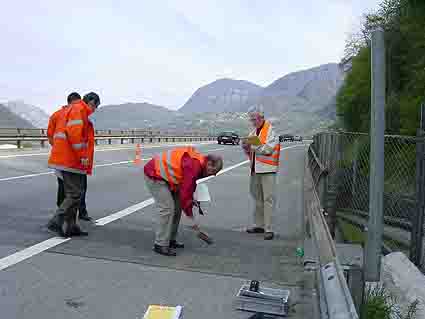One-day seminar on «Asphaltic road surface plug joint»
Asphaltic plug joints in road surfaces – greater longevity through updated guidelines?
Asphaltic road surface plug joints have been constructed in Switzerland for over five years according to the guidelines established by ASTRA, the Swiss Federal Roads Authority. An updated version of this building code will be published this year. Professionals in the field met on April 5th at the Empa Academy to learn about the latest developments from experts from Germany, Austria and Switzerland. The aim of the one-day seminar was to draw the attention of the road building industry to the greater care necessary during the construction of asphaltic plug joints in road surfaces.

|
Asphaltic road surface plug joints are quiet, watertight, flexible and quickly constructed. Since the end of the 1980s, they have been more and more frequently used for these reasons. As the components which act as the interface between roadway segments and bridge surfaces, they are subject to severe loading by both horizontal and vertical forces. Axle loads, and braking and accelerating forces often cause damage, particularly when ambient temperatures are high, leading to repair work under guarantee. However, according to unanimous feedback from German and Swiss road construction firms, the number of cases of this kind of problem has been reducing since the guidelines were introduced. Despite this, the useful life of asphaltic road surface plug joints has not yet reached the same level as those of bridge and road surfaces, which is the ultimate goal. While the road surface joints represent about one percent of the cost of a new bridge, they are responsible for about ten percent of the maintenance and repair costs, according to the Chairman of the seminar, ASTRA’s Michel Donzel.
Recommendations for the updated version of the ASTRA construction code were based on a study carried out by Empa on behalf of ASTRA and the Roadworks Department of the Canton Nidwalden, in the course of which 18 asphaltic road surface plug joints in Switzerland were observed over a 5 year period. At the focus of the investigation were the effect of material properties, the conditions under which the work was done, and the quality of construction on the operational life of the joints. One finding was that the quality of the asphalt varied considerably, even though the products were nominally identical. For this reason, certification of quality assurance in conformity with the ASTRA guidelines is an essential measure, in the opinion of Empa’s Sivotha Hean. Thorough training of workers in the handling and use of the material, assisted by the use of installation and test equipment would also have a positive effect on the operational lifetime of asphaltic road surface plug joints.
The information given in the ASTRA code is valid and appropriate, concluded Sivotha Hean in summing up the Empa project, but even so there still exists a certain amount of leeway for the construction engineers to adapt their techniques to the local conditions. Martin Gut, of Roadworks Department of the Canton Nidwalden and representing the road owners, drew a positive balance from the introduction of the building code. Both the construction firms and the road owners have adequate infrastructure and facilities to ensure that clear demarcation of responsibilities leads to improvements in quality. Daniel Delacroix, of the Swiss Interest Group on Roadway Joints and Verge Seals, spoke from the perspective of the road construction companies. It was noted that though the guidelines were used by many planners and government authorities, asphaltic road surface plug joints were still being installed without the necessary authorization. The main reason for this is that the ASTRA guidelines are only mandatory for roads which fall under the responsibility of the federal authorities. An extension of the range of applicability of the code would be very desirable both from the point of improving the longevity of road joints and to reduce disparities in the conditions affecting the competitivity of the construction companies.
The updated ASTRA guideline will be available in July 2005, and those most effected by the changes will be project planners. In order to properly evaluate road surface joint systems, they will need to take wide-ranging clarification measures. Speaker Pierre Lehmann underscored the importance of the implementation regulations which on the one hand serve to provide the contractor with a means of internal monitoring during the construction phase, and on the other are the most important control tool for the building engineer. In accordance with the implementation regulations, the construction company must provide an installations protocol, in which everything which might have an effect on the operational life of the road surface joint is recorded. At the European level, the equivalent to the ASTRA code for road surface joints, the ETAG (European Technical Approval Guideline), is still in preparation. The European guideline will replace the Swiss code only in two to three years at the earliest. Manfred N. Partl, Head of Empa’s Road Engineering/Sealing Components Laboratory expects no serious changes in respect of the testing of individual components and filling depressions, but believes that a certain tightening up of system testing will occur. For example, the mechanical resistance could be checked by performing rolling tests with a traffic simulator, or the joint extensibility of the entire system could be tested. In special cases these expensive and time consuming procedures have already been performed at the Empa. However because system tests are expensive, and given the lack of suitable and more economic alternatives, establishing a uniform code of practice in Europe is likely to prove difficult.
Autor: Manuel Martin, Contacts: |
|||
